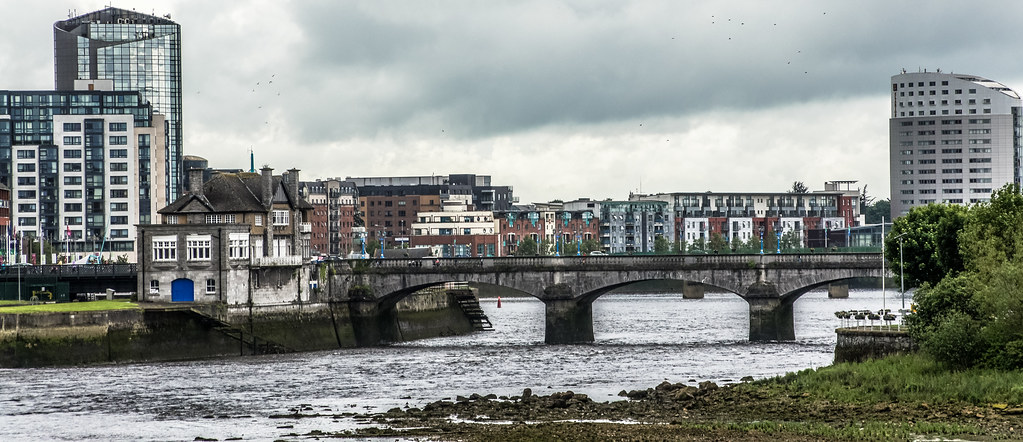SARSFIELD BRIDGE IN LIMERICK
SORRY FOR THE DELAY
The second of Limerick's River Shannon crossings is now called Sarsfield Bridge, to commemorate Patrick Sarsfield, the Earl of Lucan, who is renowned in Limerick for his role in the Williamite War and the 1691 siege and Treaty of Limerick in particular.
The bridge was opened as Wellesley Bridge on 5 August 1835, following 11 years of construction. It was designed by the Scottish engineer Alexander Nimmo and based on the Pont de Neuilly in Paris. It was a particularly important development for the city as it allowed expansion to the northern shore of the river.
The bridge itself consists of five large and elegant elliptical arches with an open balustrade, running from a man-made island, originally called Wellesley Pier but now known as Shannon Island, to the northern shore, and a simple flat, swivel deck with iron lattice railings crossing a canal and road from the island to what was known as Brunswick Street, now Sarsfield Street. The swivel end is no longer functional, although some of its heavy machinery is still intact underneath the roadway. A lock system has replaced the swivel section to allow for the passage of smaller boats. Apart from this, the bridge has remained largely unchanged since it opened and still has its original lamp standards.
Rowing clubhouses sit on Shannon Island at either side of the bridge. The Shannon Rowing Club was founded by Sir Peter Tait in 1868 and has a very elegant clubhouse on the northern side. Limerick Rowing Club was founded in 1870 and has a simpler structure on the southern side.
The Sarsfield Bridge Monument commemorates the 1916 Rising and is located on the bridge just above the Limerick Rowing Club building. An earlier monument on this site was a statue of Viscount Fitzgibbon of Mountshannon House,who was killed in The Charge of the Light Brigade at Balaclava in 1854, flanked by two Russian cannon captured in the Crimean War. This statue was blown up by the Irish Republican Army in 1930.
The War of Independence memorial is located at the northern end of the bridge, commemorating two former mayors of Limerick (George Clancy and Michael O'Callaghan), among others, who were killed by the British in 1921. The quays on the northern shore are called Clancy Strand and O'Callaghan Strand in their honour.
The bridge was opened as Wellesley Bridge on 5 August 1835, following 11 years of construction. It was designed by the Scottish engineer Alexander Nimmo and based on the Pont de Neuilly in Paris. It was a particularly important development for the city as it allowed expansion to the northern shore of the river.
The bridge itself consists of five large and elegant elliptical arches with an open balustrade, running from a man-made island, originally called Wellesley Pier but now known as Shannon Island, to the northern shore, and a simple flat, swivel deck with iron lattice railings crossing a canal and road from the island to what was known as Brunswick Street, now Sarsfield Street. The swivel end is no longer functional, although some of its heavy machinery is still intact underneath the roadway. A lock system has replaced the swivel section to allow for the passage of smaller boats. Apart from this, the bridge has remained largely unchanged since it opened and still has its original lamp standards.
Rowing clubhouses sit on Shannon Island at either side of the bridge. The Shannon Rowing Club was founded by Sir Peter Tait in 1868 and has a very elegant clubhouse on the northern side. Limerick Rowing Club was founded in 1870 and has a simpler structure on the southern side.
The Sarsfield Bridge Monument commemorates the 1916 Rising and is located on the bridge just above the Limerick Rowing Club building. An earlier monument on this site was a statue of Viscount Fitzgibbon of Mountshannon House,who was killed in The Charge of the Light Brigade at Balaclava in 1854, flanked by two Russian cannon captured in the Crimean War. This statue was blown up by the Irish Republican Army in 1930.
The War of Independence memorial is located at the northern end of the bridge, commemorating two former mayors of Limerick (George Clancy and Michael O'Callaghan), among others, who were killed by the British in 1921. The quays on the northern shore are called Clancy Strand and O'Callaghan Strand in their honour.
